The Unintended Effects of Economic Policies: A Comprehensive Analysis
VerifiedAdded on 2020/03/01
|10
|2592
|45
Essay
AI Summary
This essay delves into the unintended effects of various economic policies, including minimum wage, earned income tax credits, and social security, with a specific focus on the context of Singapore. The paper begins by highlighting the increasing income inequality and wage stagnation observed in many countries, including Singapore. It then analyzes the potential negative consequences of policies designed to combat poverty, such as the unemployment resulting from minimum wage laws, the limitations and fraud associated with tax credit policies, and the financial burdens that social security policies place on higher earners. The analysis uses economic theories and empirical evidence to evaluate the effectiveness and drawbacks of these policies. The essay concludes by emphasizing the need for policy reforms in Singapore to address wage stagnation and income inequality and suggesting a need for a better social security system to alleviate poverty.
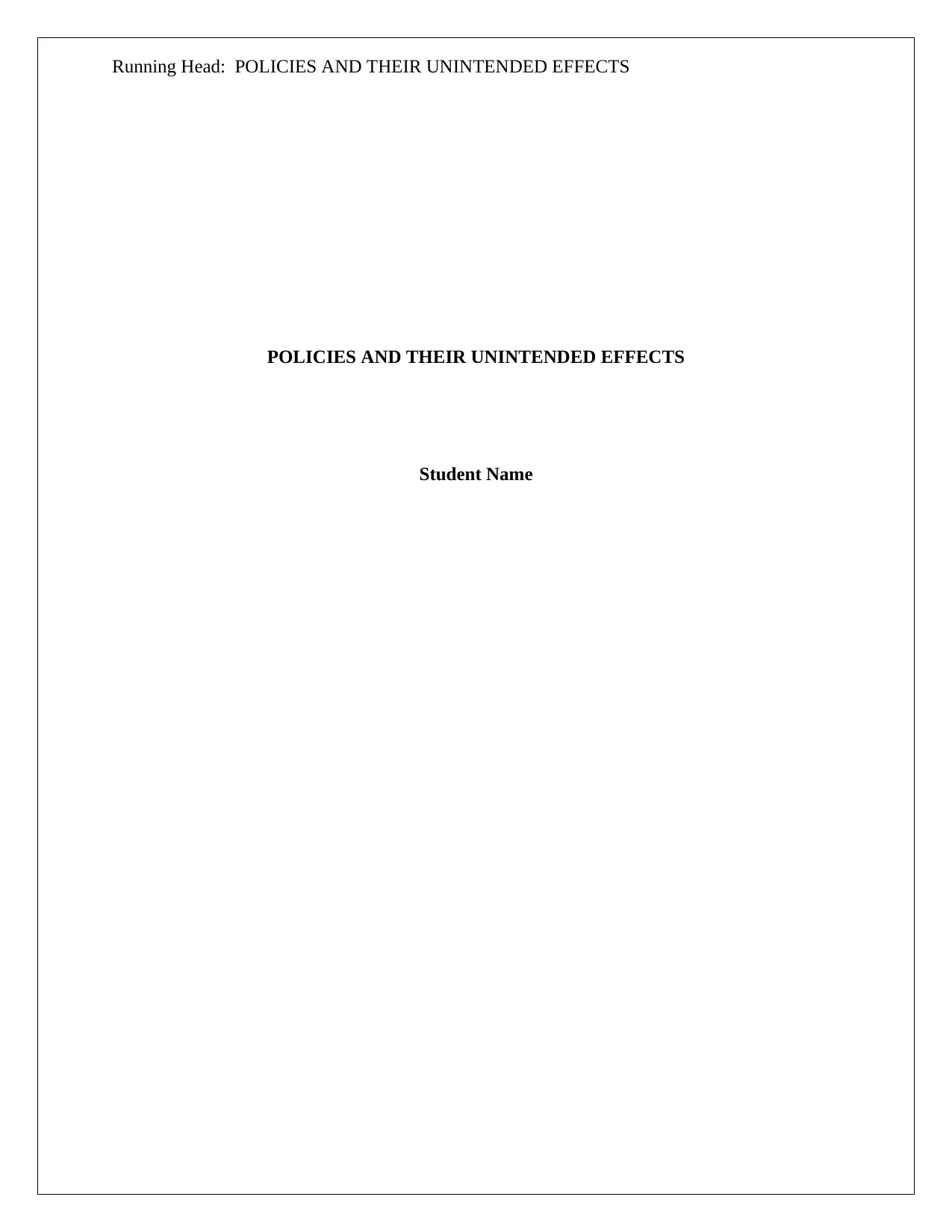
Running Head: POLICIES AND THEIR UNINTENDED EFFECTS
POLICIES AND THEIR UNINTENDED EFFECTS
Student Name
POLICIES AND THEIR UNINTENDED EFFECTS
Student Name
Paraphrase This Document
Need a fresh take? Get an instant paraphrase of this document with our AI Paraphraser
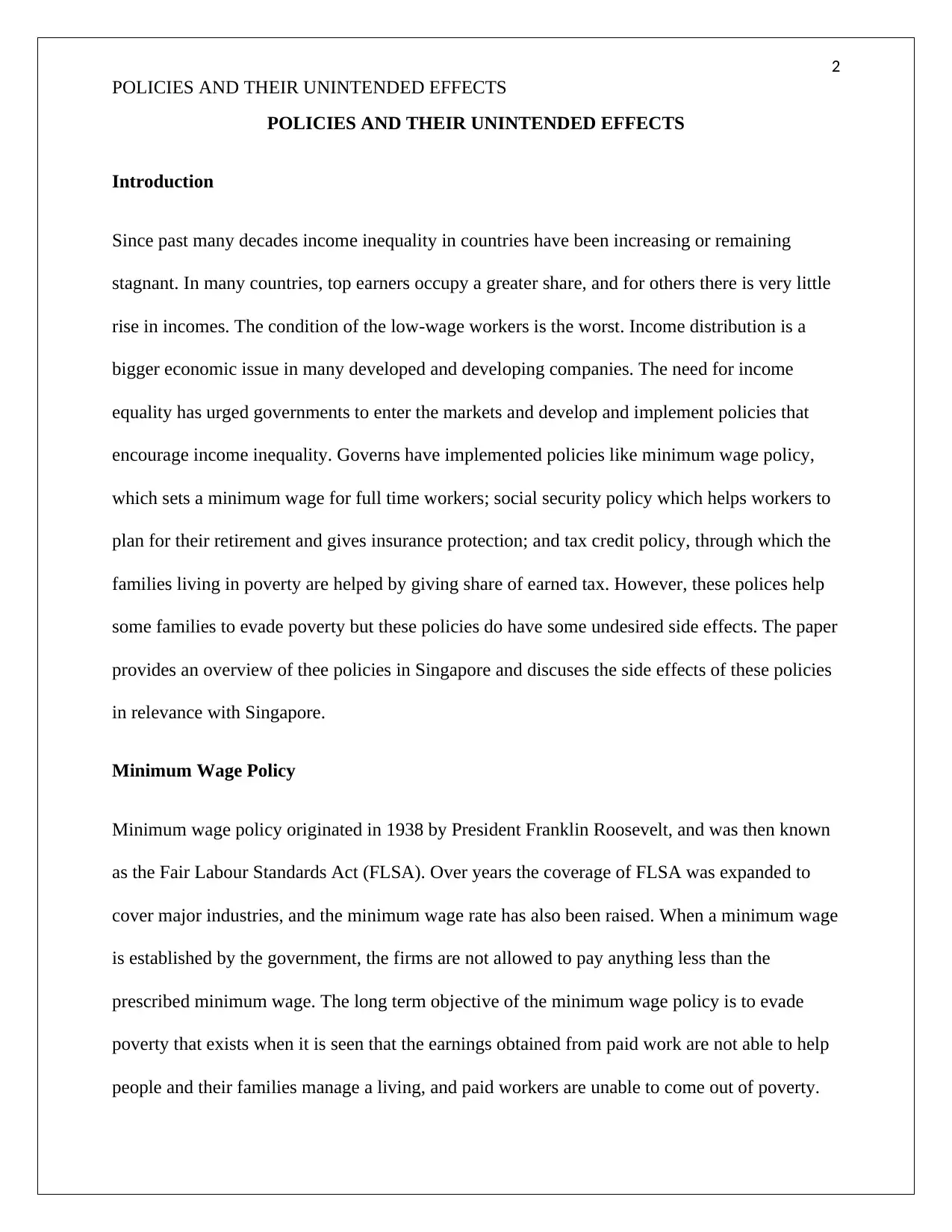
2
POLICIES AND THEIR UNINTENDED EFFECTS
POLICIES AND THEIR UNINTENDED EFFECTS
Introduction
Since past many decades income inequality in countries have been increasing or remaining
stagnant. In many countries, top earners occupy a greater share, and for others there is very little
rise in incomes. The condition of the low-wage workers is the worst. Income distribution is a
bigger economic issue in many developed and developing companies. The need for income
equality has urged governments to enter the markets and develop and implement policies that
encourage income inequality. Governs have implemented policies like minimum wage policy,
which sets a minimum wage for full time workers; social security policy which helps workers to
plan for their retirement and gives insurance protection; and tax credit policy, through which the
families living in poverty are helped by giving share of earned tax. However, these polices help
some families to evade poverty but these policies do have some undesired side effects. The paper
provides an overview of thee policies in Singapore and discuses the side effects of these policies
in relevance with Singapore.
Minimum Wage Policy
Minimum wage policy originated in 1938 by President Franklin Roosevelt, and was then known
as the Fair Labour Standards Act (FLSA). Over years the coverage of FLSA was expanded to
cover major industries, and the minimum wage rate has also been raised. When a minimum wage
is established by the government, the firms are not allowed to pay anything less than the
prescribed minimum wage. The long term objective of the minimum wage policy is to evade
poverty that exists when it is seen that the earnings obtained from paid work are not able to help
people and their families manage a living, and paid workers are unable to come out of poverty.
POLICIES AND THEIR UNINTENDED EFFECTS
POLICIES AND THEIR UNINTENDED EFFECTS
Introduction
Since past many decades income inequality in countries have been increasing or remaining
stagnant. In many countries, top earners occupy a greater share, and for others there is very little
rise in incomes. The condition of the low-wage workers is the worst. Income distribution is a
bigger economic issue in many developed and developing companies. The need for income
equality has urged governments to enter the markets and develop and implement policies that
encourage income inequality. Governs have implemented policies like minimum wage policy,
which sets a minimum wage for full time workers; social security policy which helps workers to
plan for their retirement and gives insurance protection; and tax credit policy, through which the
families living in poverty are helped by giving share of earned tax. However, these polices help
some families to evade poverty but these policies do have some undesired side effects. The paper
provides an overview of thee policies in Singapore and discuses the side effects of these policies
in relevance with Singapore.
Minimum Wage Policy
Minimum wage policy originated in 1938 by President Franklin Roosevelt, and was then known
as the Fair Labour Standards Act (FLSA). Over years the coverage of FLSA was expanded to
cover major industries, and the minimum wage rate has also been raised. When a minimum wage
is established by the government, the firms are not allowed to pay anything less than the
prescribed minimum wage. The long term objective of the minimum wage policy is to evade
poverty that exists when it is seen that the earnings obtained from paid work are not able to help
people and their families manage a living, and paid workers are unable to come out of poverty.
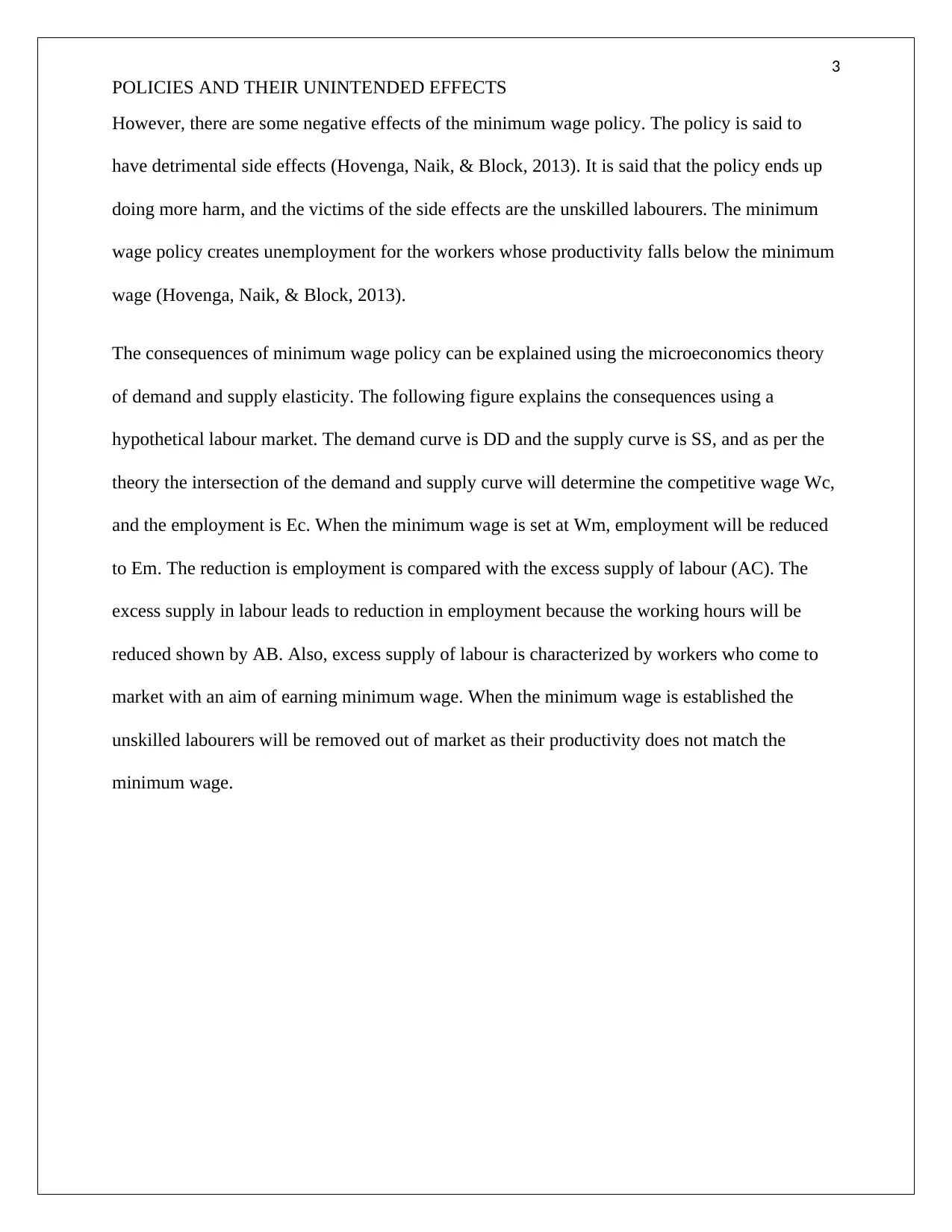
3
POLICIES AND THEIR UNINTENDED EFFECTS
However, there are some negative effects of the minimum wage policy. The policy is said to
have detrimental side effects (Hovenga, Naik, & Block, 2013). It is said that the policy ends up
doing more harm, and the victims of the side effects are the unskilled labourers. The minimum
wage policy creates unemployment for the workers whose productivity falls below the minimum
wage (Hovenga, Naik, & Block, 2013).
The consequences of minimum wage policy can be explained using the microeconomics theory
of demand and supply elasticity. The following figure explains the consequences using a
hypothetical labour market. The demand curve is DD and the supply curve is SS, and as per the
theory the intersection of the demand and supply curve will determine the competitive wage Wc,
and the employment is Ec. When the minimum wage is set at Wm, employment will be reduced
to Em. The reduction is employment is compared with the excess supply of labour (AC). The
excess supply in labour leads to reduction in employment because the working hours will be
reduced shown by AB. Also, excess supply of labour is characterized by workers who come to
market with an aim of earning minimum wage. When the minimum wage is established the
unskilled labourers will be removed out of market as their productivity does not match the
minimum wage.
POLICIES AND THEIR UNINTENDED EFFECTS
However, there are some negative effects of the minimum wage policy. The policy is said to
have detrimental side effects (Hovenga, Naik, & Block, 2013). It is said that the policy ends up
doing more harm, and the victims of the side effects are the unskilled labourers. The minimum
wage policy creates unemployment for the workers whose productivity falls below the minimum
wage (Hovenga, Naik, & Block, 2013).
The consequences of minimum wage policy can be explained using the microeconomics theory
of demand and supply elasticity. The following figure explains the consequences using a
hypothetical labour market. The demand curve is DD and the supply curve is SS, and as per the
theory the intersection of the demand and supply curve will determine the competitive wage Wc,
and the employment is Ec. When the minimum wage is set at Wm, employment will be reduced
to Em. The reduction is employment is compared with the excess supply of labour (AC). The
excess supply in labour leads to reduction in employment because the working hours will be
reduced shown by AB. Also, excess supply of labour is characterized by workers who come to
market with an aim of earning minimum wage. When the minimum wage is established the
unskilled labourers will be removed out of market as their productivity does not match the
minimum wage.
⊘ This is a preview!⊘
Do you want full access?
Subscribe today to unlock all pages.

Trusted by 1+ million students worldwide
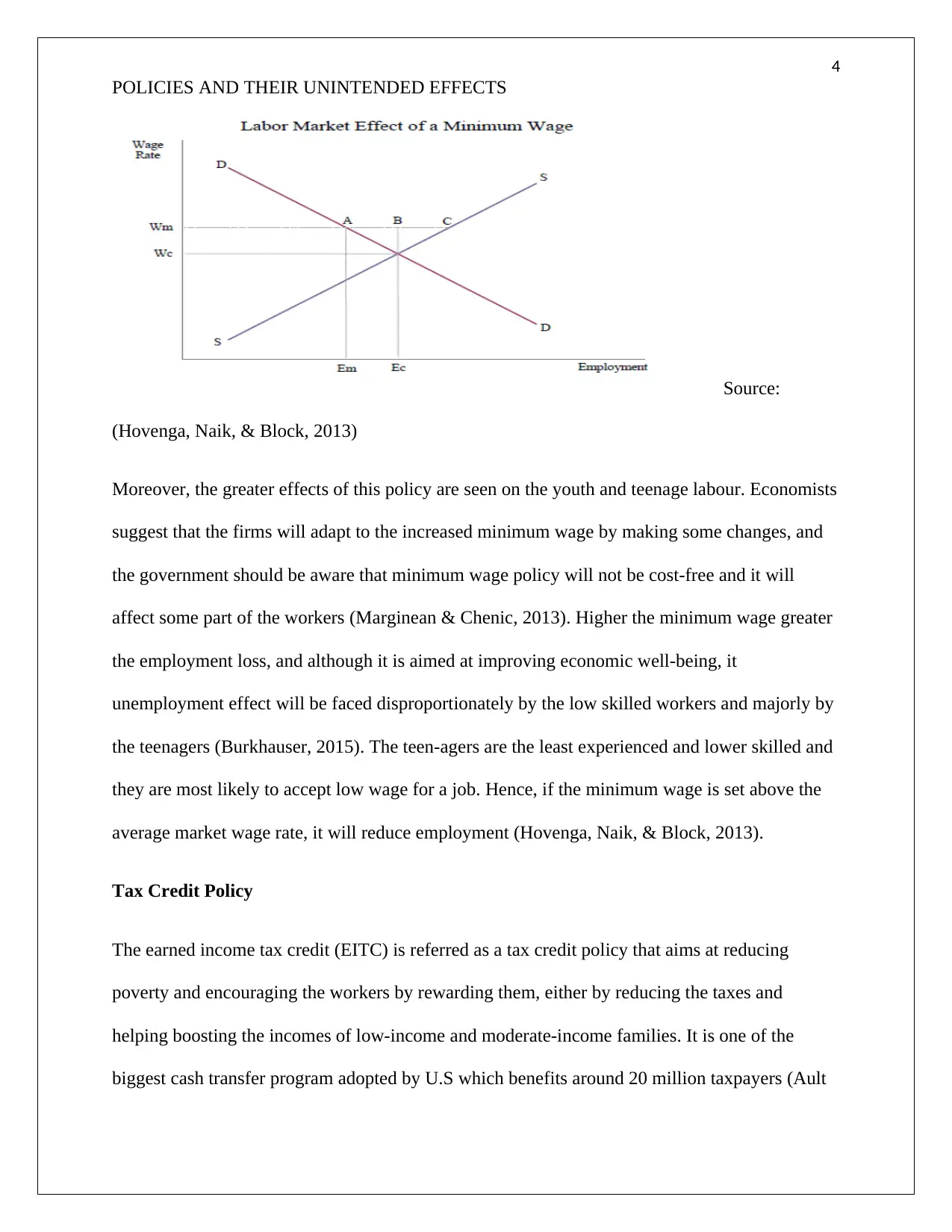
4
POLICIES AND THEIR UNINTENDED EFFECTS
Source:
(Hovenga, Naik, & Block, 2013)
Moreover, the greater effects of this policy are seen on the youth and teenage labour. Economists
suggest that the firms will adapt to the increased minimum wage by making some changes, and
the government should be aware that minimum wage policy will not be cost-free and it will
affect some part of the workers (Marginean & Chenic, 2013). Higher the minimum wage greater
the employment loss, and although it is aimed at improving economic well-being, it
unemployment effect will be faced disproportionately by the low skilled workers and majorly by
the teenagers (Burkhauser, 2015). The teen-agers are the least experienced and lower skilled and
they are most likely to accept low wage for a job. Hence, if the minimum wage is set above the
average market wage rate, it will reduce employment (Hovenga, Naik, & Block, 2013).
Tax Credit Policy
The earned income tax credit (EITC) is referred as a tax credit policy that aims at reducing
poverty and encouraging the workers by rewarding them, either by reducing the taxes and
helping boosting the incomes of low-income and moderate-income families. It is one of the
biggest cash transfer program adopted by U.S which benefits around 20 million taxpayers (Ault
POLICIES AND THEIR UNINTENDED EFFECTS
Source:
(Hovenga, Naik, & Block, 2013)
Moreover, the greater effects of this policy are seen on the youth and teenage labour. Economists
suggest that the firms will adapt to the increased minimum wage by making some changes, and
the government should be aware that minimum wage policy will not be cost-free and it will
affect some part of the workers (Marginean & Chenic, 2013). Higher the minimum wage greater
the employment loss, and although it is aimed at improving economic well-being, it
unemployment effect will be faced disproportionately by the low skilled workers and majorly by
the teenagers (Burkhauser, 2015). The teen-agers are the least experienced and lower skilled and
they are most likely to accept low wage for a job. Hence, if the minimum wage is set above the
average market wage rate, it will reduce employment (Hovenga, Naik, & Block, 2013).
Tax Credit Policy
The earned income tax credit (EITC) is referred as a tax credit policy that aims at reducing
poverty and encouraging the workers by rewarding them, either by reducing the taxes and
helping boosting the incomes of low-income and moderate-income families. It is one of the
biggest cash transfer program adopted by U.S which benefits around 20 million taxpayers (Ault
Paraphrase This Document
Need a fresh take? Get an instant paraphrase of this document with our AI Paraphraser
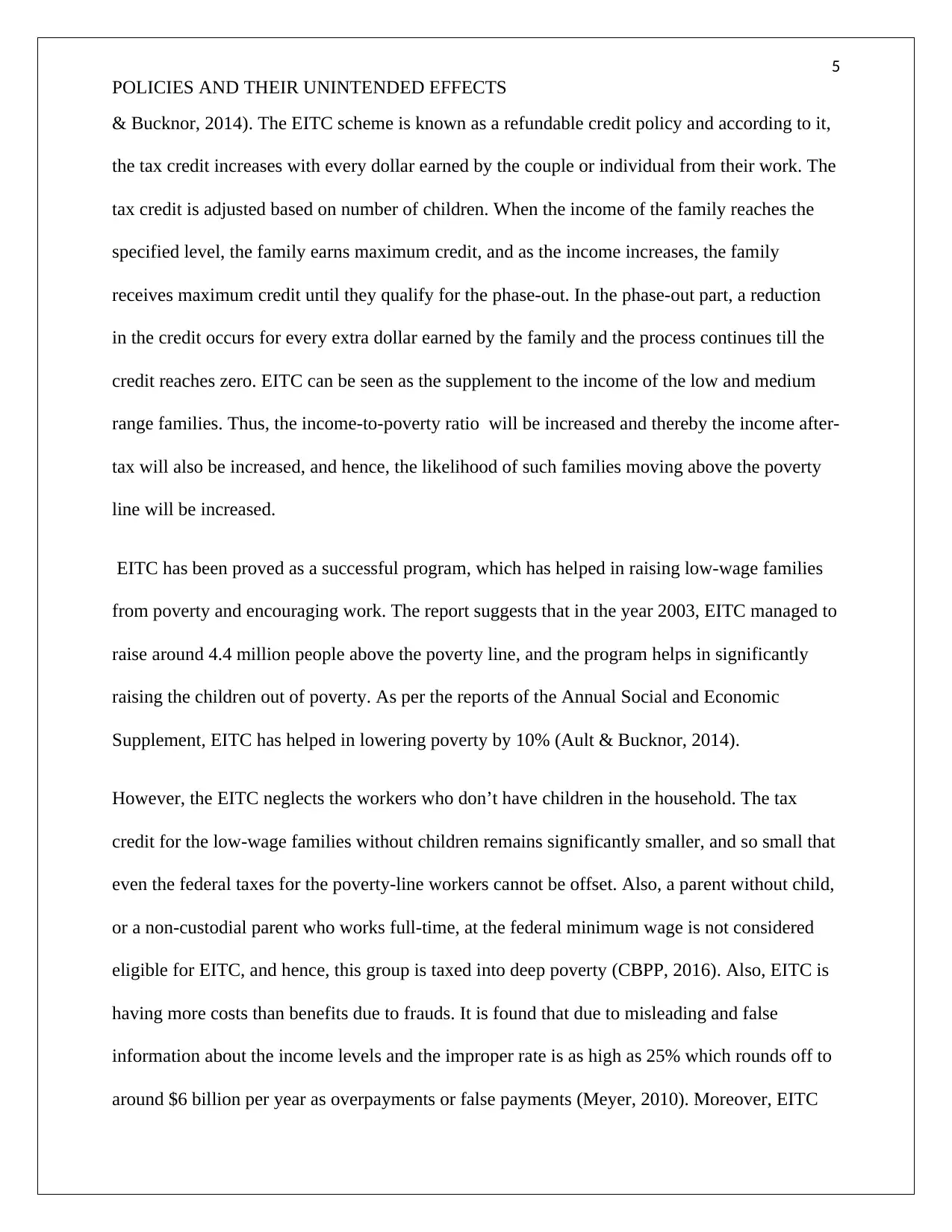
5
POLICIES AND THEIR UNINTENDED EFFECTS
& Bucknor, 2014). The EITC scheme is known as a refundable credit policy and according to it,
the tax credit increases with every dollar earned by the couple or individual from their work. The
tax credit is adjusted based on number of children. When the income of the family reaches the
specified level, the family earns maximum credit, and as the income increases, the family
receives maximum credit until they qualify for the phase-out. In the phase-out part, a reduction
in the credit occurs for every extra dollar earned by the family and the process continues till the
credit reaches zero. EITC can be seen as the supplement to the income of the low and medium
range families. Thus, the income-to-poverty ratio will be increased and thereby the income after-
tax will also be increased, and hence, the likelihood of such families moving above the poverty
line will be increased.
EITC has been proved as a successful program, which has helped in raising low-wage families
from poverty and encouraging work. The report suggests that in the year 2003, EITC managed to
raise around 4.4 million people above the poverty line, and the program helps in significantly
raising the children out of poverty. As per the reports of the Annual Social and Economic
Supplement, EITC has helped in lowering poverty by 10% (Ault & Bucknor, 2014).
However, the EITC neglects the workers who don’t have children in the household. The tax
credit for the low-wage families without children remains significantly smaller, and so small that
even the federal taxes for the poverty-line workers cannot be offset. Also, a parent without child,
or a non-custodial parent who works full-time, at the federal minimum wage is not considered
eligible for EITC, and hence, this group is taxed into deep poverty (CBPP, 2016). Also, EITC is
having more costs than benefits due to frauds. It is found that due to misleading and false
information about the income levels and the improper rate is as high as 25% which rounds off to
around $6 billion per year as overpayments or false payments (Meyer, 2010). Moreover, EITC
POLICIES AND THEIR UNINTENDED EFFECTS
& Bucknor, 2014). The EITC scheme is known as a refundable credit policy and according to it,
the tax credit increases with every dollar earned by the couple or individual from their work. The
tax credit is adjusted based on number of children. When the income of the family reaches the
specified level, the family earns maximum credit, and as the income increases, the family
receives maximum credit until they qualify for the phase-out. In the phase-out part, a reduction
in the credit occurs for every extra dollar earned by the family and the process continues till the
credit reaches zero. EITC can be seen as the supplement to the income of the low and medium
range families. Thus, the income-to-poverty ratio will be increased and thereby the income after-
tax will also be increased, and hence, the likelihood of such families moving above the poverty
line will be increased.
EITC has been proved as a successful program, which has helped in raising low-wage families
from poverty and encouraging work. The report suggests that in the year 2003, EITC managed to
raise around 4.4 million people above the poverty line, and the program helps in significantly
raising the children out of poverty. As per the reports of the Annual Social and Economic
Supplement, EITC has helped in lowering poverty by 10% (Ault & Bucknor, 2014).
However, the EITC neglects the workers who don’t have children in the household. The tax
credit for the low-wage families without children remains significantly smaller, and so small that
even the federal taxes for the poverty-line workers cannot be offset. Also, a parent without child,
or a non-custodial parent who works full-time, at the federal minimum wage is not considered
eligible for EITC, and hence, this group is taxed into deep poverty (CBPP, 2016). Also, EITC is
having more costs than benefits due to frauds. It is found that due to misleading and false
information about the income levels and the improper rate is as high as 25% which rounds off to
around $6 billion per year as overpayments or false payments (Meyer, 2010). Moreover, EITC
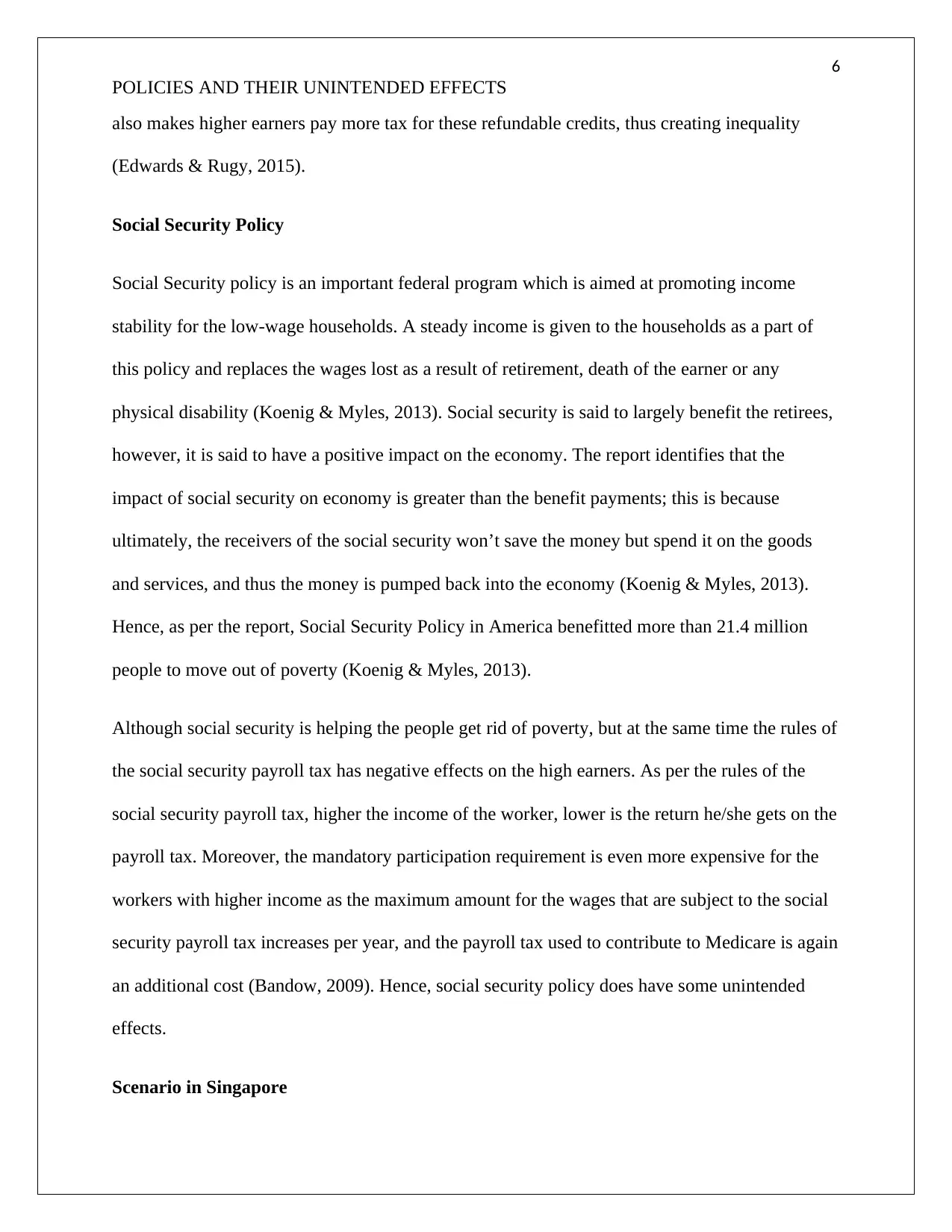
6
POLICIES AND THEIR UNINTENDED EFFECTS
also makes higher earners pay more tax for these refundable credits, thus creating inequality
(Edwards & Rugy, 2015).
Social Security Policy
Social Security policy is an important federal program which is aimed at promoting income
stability for the low-wage households. A steady income is given to the households as a part of
this policy and replaces the wages lost as a result of retirement, death of the earner or any
physical disability (Koenig & Myles, 2013). Social security is said to largely benefit the retirees,
however, it is said to have a positive impact on the economy. The report identifies that the
impact of social security on economy is greater than the benefit payments; this is because
ultimately, the receivers of the social security won’t save the money but spend it on the goods
and services, and thus the money is pumped back into the economy (Koenig & Myles, 2013).
Hence, as per the report, Social Security Policy in America benefitted more than 21.4 million
people to move out of poverty (Koenig & Myles, 2013).
Although social security is helping the people get rid of poverty, but at the same time the rules of
the social security payroll tax has negative effects on the high earners. As per the rules of the
social security payroll tax, higher the income of the worker, lower is the return he/she gets on the
payroll tax. Moreover, the mandatory participation requirement is even more expensive for the
workers with higher income as the maximum amount for the wages that are subject to the social
security payroll tax increases per year, and the payroll tax used to contribute to Medicare is again
an additional cost (Bandow, 2009). Hence, social security policy does have some unintended
effects.
Scenario in Singapore
POLICIES AND THEIR UNINTENDED EFFECTS
also makes higher earners pay more tax for these refundable credits, thus creating inequality
(Edwards & Rugy, 2015).
Social Security Policy
Social Security policy is an important federal program which is aimed at promoting income
stability for the low-wage households. A steady income is given to the households as a part of
this policy and replaces the wages lost as a result of retirement, death of the earner or any
physical disability (Koenig & Myles, 2013). Social security is said to largely benefit the retirees,
however, it is said to have a positive impact on the economy. The report identifies that the
impact of social security on economy is greater than the benefit payments; this is because
ultimately, the receivers of the social security won’t save the money but spend it on the goods
and services, and thus the money is pumped back into the economy (Koenig & Myles, 2013).
Hence, as per the report, Social Security Policy in America benefitted more than 21.4 million
people to move out of poverty (Koenig & Myles, 2013).
Although social security is helping the people get rid of poverty, but at the same time the rules of
the social security payroll tax has negative effects on the high earners. As per the rules of the
social security payroll tax, higher the income of the worker, lower is the return he/she gets on the
payroll tax. Moreover, the mandatory participation requirement is even more expensive for the
workers with higher income as the maximum amount for the wages that are subject to the social
security payroll tax increases per year, and the payroll tax used to contribute to Medicare is again
an additional cost (Bandow, 2009). Hence, social security policy does have some unintended
effects.
Scenario in Singapore
⊘ This is a preview!⊘
Do you want full access?
Subscribe today to unlock all pages.

Trusted by 1+ million students worldwide
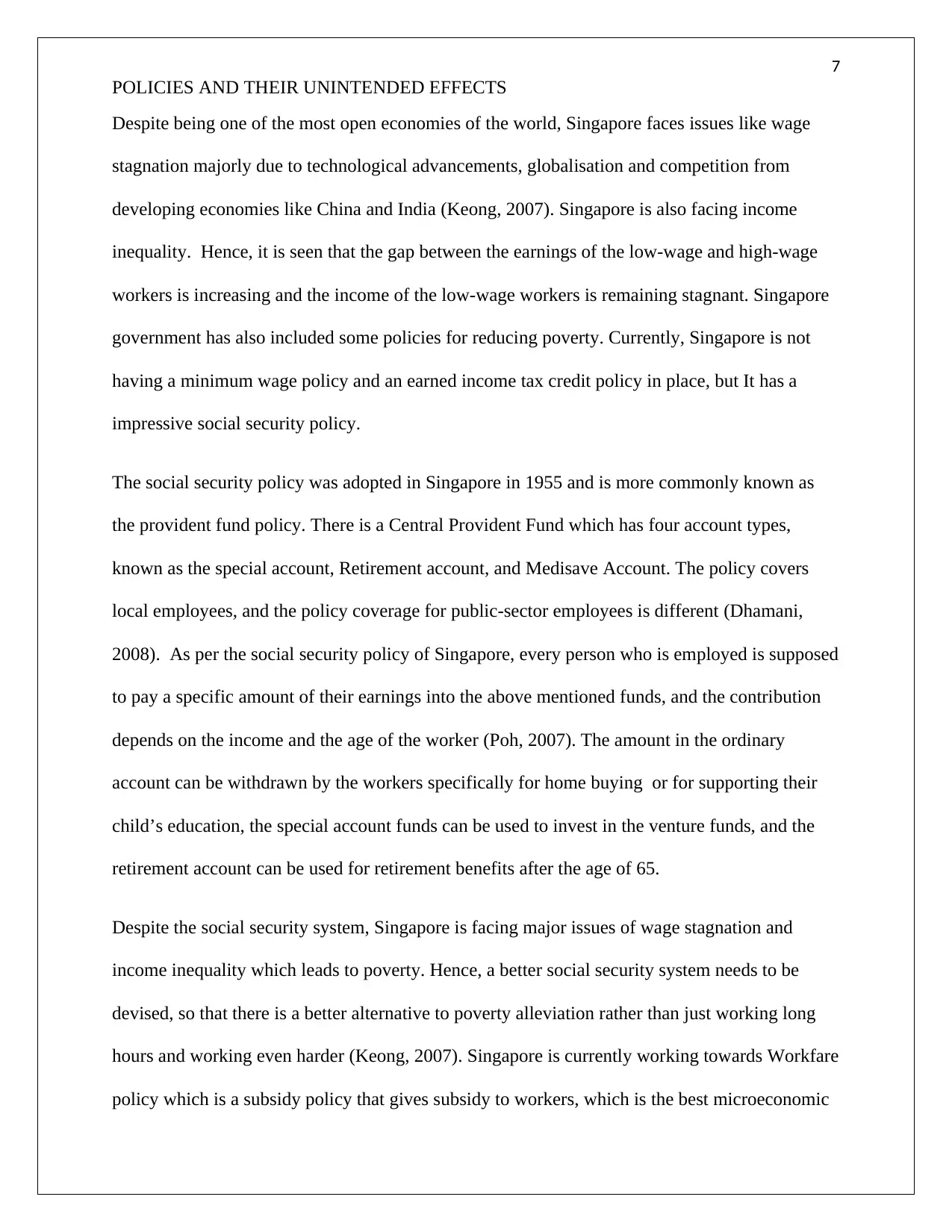
7
POLICIES AND THEIR UNINTENDED EFFECTS
Despite being one of the most open economies of the world, Singapore faces issues like wage
stagnation majorly due to technological advancements, globalisation and competition from
developing economies like China and India (Keong, 2007). Singapore is also facing income
inequality. Hence, it is seen that the gap between the earnings of the low-wage and high-wage
workers is increasing and the income of the low-wage workers is remaining stagnant. Singapore
government has also included some policies for reducing poverty. Currently, Singapore is not
having a minimum wage policy and an earned income tax credit policy in place, but It has a
impressive social security policy.
The social security policy was adopted in Singapore in 1955 and is more commonly known as
the provident fund policy. There is a Central Provident Fund which has four account types,
known as the special account, Retirement account, and Medisave Account. The policy covers
local employees, and the policy coverage for public-sector employees is different (Dhamani,
2008). As per the social security policy of Singapore, every person who is employed is supposed
to pay a specific amount of their earnings into the above mentioned funds, and the contribution
depends on the income and the age of the worker (Poh, 2007). The amount in the ordinary
account can be withdrawn by the workers specifically for home buying or for supporting their
child’s education, the special account funds can be used to invest in the venture funds, and the
retirement account can be used for retirement benefits after the age of 65.
Despite the social security system, Singapore is facing major issues of wage stagnation and
income inequality which leads to poverty. Hence, a better social security system needs to be
devised, so that there is a better alternative to poverty alleviation rather than just working long
hours and working even harder (Keong, 2007). Singapore is currently working towards Workfare
policy which is a subsidy policy that gives subsidy to workers, which is the best microeconomic
POLICIES AND THEIR UNINTENDED EFFECTS
Despite being one of the most open economies of the world, Singapore faces issues like wage
stagnation majorly due to technological advancements, globalisation and competition from
developing economies like China and India (Keong, 2007). Singapore is also facing income
inequality. Hence, it is seen that the gap between the earnings of the low-wage and high-wage
workers is increasing and the income of the low-wage workers is remaining stagnant. Singapore
government has also included some policies for reducing poverty. Currently, Singapore is not
having a minimum wage policy and an earned income tax credit policy in place, but It has a
impressive social security policy.
The social security policy was adopted in Singapore in 1955 and is more commonly known as
the provident fund policy. There is a Central Provident Fund which has four account types,
known as the special account, Retirement account, and Medisave Account. The policy covers
local employees, and the policy coverage for public-sector employees is different (Dhamani,
2008). As per the social security policy of Singapore, every person who is employed is supposed
to pay a specific amount of their earnings into the above mentioned funds, and the contribution
depends on the income and the age of the worker (Poh, 2007). The amount in the ordinary
account can be withdrawn by the workers specifically for home buying or for supporting their
child’s education, the special account funds can be used to invest in the venture funds, and the
retirement account can be used for retirement benefits after the age of 65.
Despite the social security system, Singapore is facing major issues of wage stagnation and
income inequality which leads to poverty. Hence, a better social security system needs to be
devised, so that there is a better alternative to poverty alleviation rather than just working long
hours and working even harder (Keong, 2007). Singapore is currently working towards Workfare
policy which is a subsidy policy that gives subsidy to workers, which is the best microeconomic
Paraphrase This Document
Need a fresh take? Get an instant paraphrase of this document with our AI Paraphraser
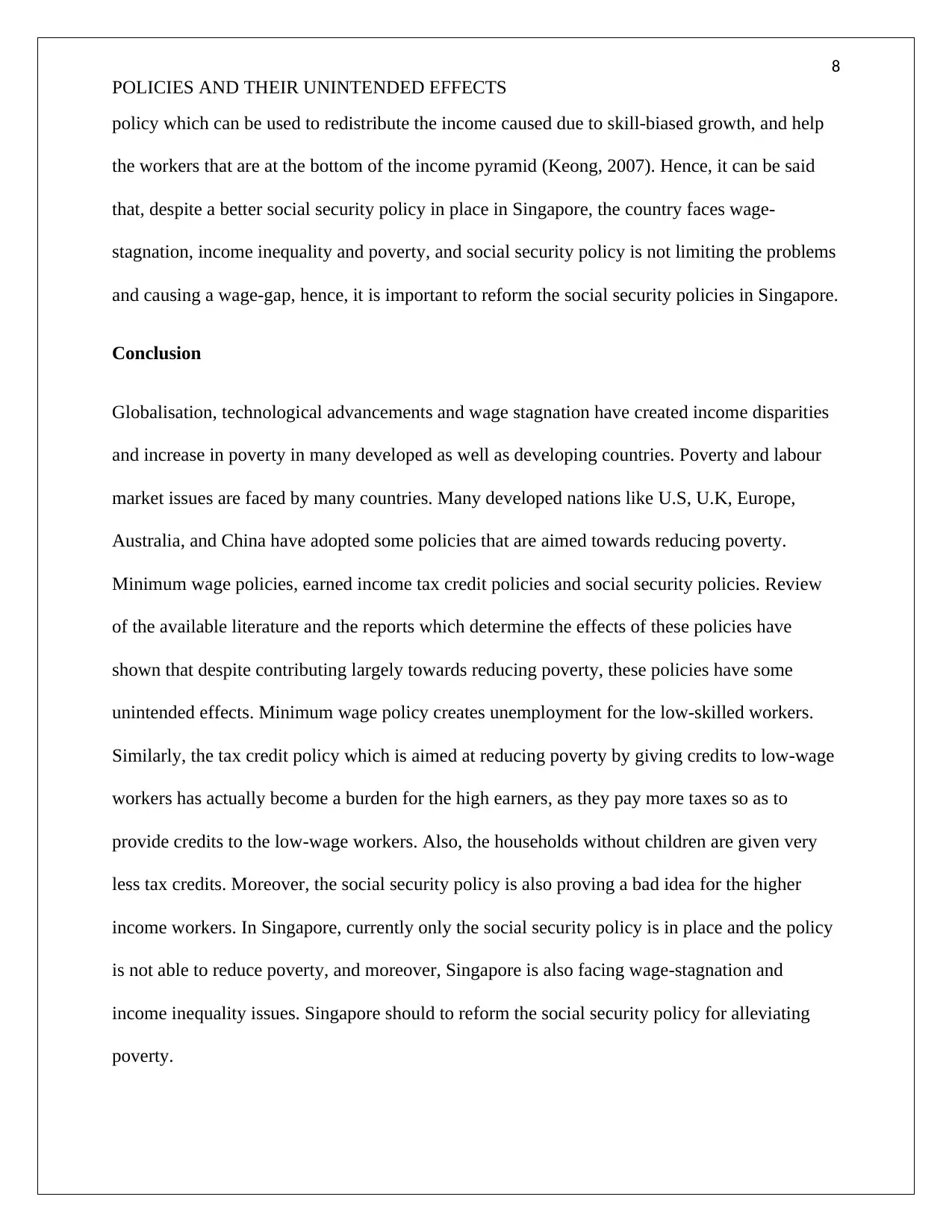
8
POLICIES AND THEIR UNINTENDED EFFECTS
policy which can be used to redistribute the income caused due to skill-biased growth, and help
the workers that are at the bottom of the income pyramid (Keong, 2007). Hence, it can be said
that, despite a better social security policy in place in Singapore, the country faces wage-
stagnation, income inequality and poverty, and social security policy is not limiting the problems
and causing a wage-gap, hence, it is important to reform the social security policies in Singapore.
Conclusion
Globalisation, technological advancements and wage stagnation have created income disparities
and increase in poverty in many developed as well as developing countries. Poverty and labour
market issues are faced by many countries. Many developed nations like U.S, U.K, Europe,
Australia, and China have adopted some policies that are aimed towards reducing poverty.
Minimum wage policies, earned income tax credit policies and social security policies. Review
of the available literature and the reports which determine the effects of these policies have
shown that despite contributing largely towards reducing poverty, these policies have some
unintended effects. Minimum wage policy creates unemployment for the low-skilled workers.
Similarly, the tax credit policy which is aimed at reducing poverty by giving credits to low-wage
workers has actually become a burden for the high earners, as they pay more taxes so as to
provide credits to the low-wage workers. Also, the households without children are given very
less tax credits. Moreover, the social security policy is also proving a bad idea for the higher
income workers. In Singapore, currently only the social security policy is in place and the policy
is not able to reduce poverty, and moreover, Singapore is also facing wage-stagnation and
income inequality issues. Singapore should to reform the social security policy for alleviating
poverty.
POLICIES AND THEIR UNINTENDED EFFECTS
policy which can be used to redistribute the income caused due to skill-biased growth, and help
the workers that are at the bottom of the income pyramid (Keong, 2007). Hence, it can be said
that, despite a better social security policy in place in Singapore, the country faces wage-
stagnation, income inequality and poverty, and social security policy is not limiting the problems
and causing a wage-gap, hence, it is important to reform the social security policies in Singapore.
Conclusion
Globalisation, technological advancements and wage stagnation have created income disparities
and increase in poverty in many developed as well as developing countries. Poverty and labour
market issues are faced by many countries. Many developed nations like U.S, U.K, Europe,
Australia, and China have adopted some policies that are aimed towards reducing poverty.
Minimum wage policies, earned income tax credit policies and social security policies. Review
of the available literature and the reports which determine the effects of these policies have
shown that despite contributing largely towards reducing poverty, these policies have some
unintended effects. Minimum wage policy creates unemployment for the low-skilled workers.
Similarly, the tax credit policy which is aimed at reducing poverty by giving credits to low-wage
workers has actually become a burden for the high earners, as they pay more taxes so as to
provide credits to the low-wage workers. Also, the households without children are given very
less tax credits. Moreover, the social security policy is also proving a bad idea for the higher
income workers. In Singapore, currently only the social security policy is in place and the policy
is not able to reduce poverty, and moreover, Singapore is also facing wage-stagnation and
income inequality issues. Singapore should to reform the social security policy for alleviating
poverty.
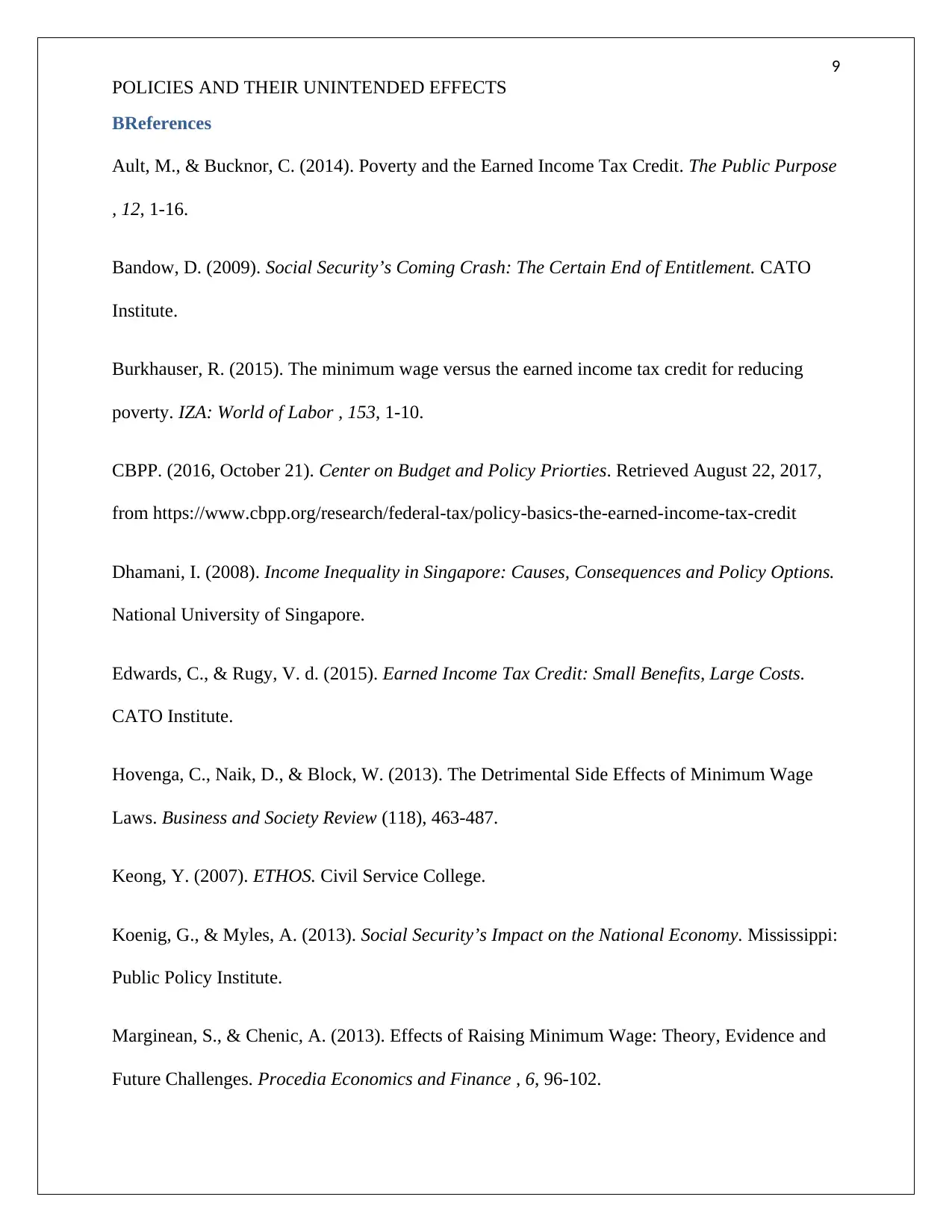
9
POLICIES AND THEIR UNINTENDED EFFECTS
BReferences
Ault, M., & Bucknor, C. (2014). Poverty and the Earned Income Tax Credit. The Public Purpose
, 12, 1-16.
Bandow, D. (2009). Social Security’s Coming Crash: The Certain End of Entitlement. CATO
Institute.
Burkhauser, R. (2015). The minimum wage versus the earned income tax credit for reducing
poverty. IZA: World of Labor , 153, 1-10.
CBPP. (2016, October 21). Center on Budget and Policy Priorties. Retrieved August 22, 2017,
from https://www.cbpp.org/research/federal-tax/policy-basics-the-earned-income-tax-credit
Dhamani, I. (2008). Income Inequality in Singapore: Causes, Consequences and Policy Options.
National University of Singapore.
Edwards, C., & Rugy, V. d. (2015). Earned Income Tax Credit: Small Benefits, Large Costs.
CATO Institute.
Hovenga, C., Naik, D., & Block, W. (2013). The Detrimental Side Effects of Minimum Wage
Laws. Business and Society Review (118), 463-487.
Keong, Y. (2007). ETHOS. Civil Service College.
Koenig, G., & Myles, A. (2013). Social Security’s Impact on the National Economy. Mississippi:
Public Policy Institute.
Marginean, S., & Chenic, A. (2013). Effects of Raising Minimum Wage: Theory, Evidence and
Future Challenges. Procedia Economics and Finance , 6, 96-102.
POLICIES AND THEIR UNINTENDED EFFECTS
BReferences
Ault, M., & Bucknor, C. (2014). Poverty and the Earned Income Tax Credit. The Public Purpose
, 12, 1-16.
Bandow, D. (2009). Social Security’s Coming Crash: The Certain End of Entitlement. CATO
Institute.
Burkhauser, R. (2015). The minimum wage versus the earned income tax credit for reducing
poverty. IZA: World of Labor , 153, 1-10.
CBPP. (2016, October 21). Center on Budget and Policy Priorties. Retrieved August 22, 2017,
from https://www.cbpp.org/research/federal-tax/policy-basics-the-earned-income-tax-credit
Dhamani, I. (2008). Income Inequality in Singapore: Causes, Consequences and Policy Options.
National University of Singapore.
Edwards, C., & Rugy, V. d. (2015). Earned Income Tax Credit: Small Benefits, Large Costs.
CATO Institute.
Hovenga, C., Naik, D., & Block, W. (2013). The Detrimental Side Effects of Minimum Wage
Laws. Business and Society Review (118), 463-487.
Keong, Y. (2007). ETHOS. Civil Service College.
Koenig, G., & Myles, A. (2013). Social Security’s Impact on the National Economy. Mississippi:
Public Policy Institute.
Marginean, S., & Chenic, A. (2013). Effects of Raising Minimum Wage: Theory, Evidence and
Future Challenges. Procedia Economics and Finance , 6, 96-102.
⊘ This is a preview!⊘
Do you want full access?
Subscribe today to unlock all pages.

Trusted by 1+ million students worldwide
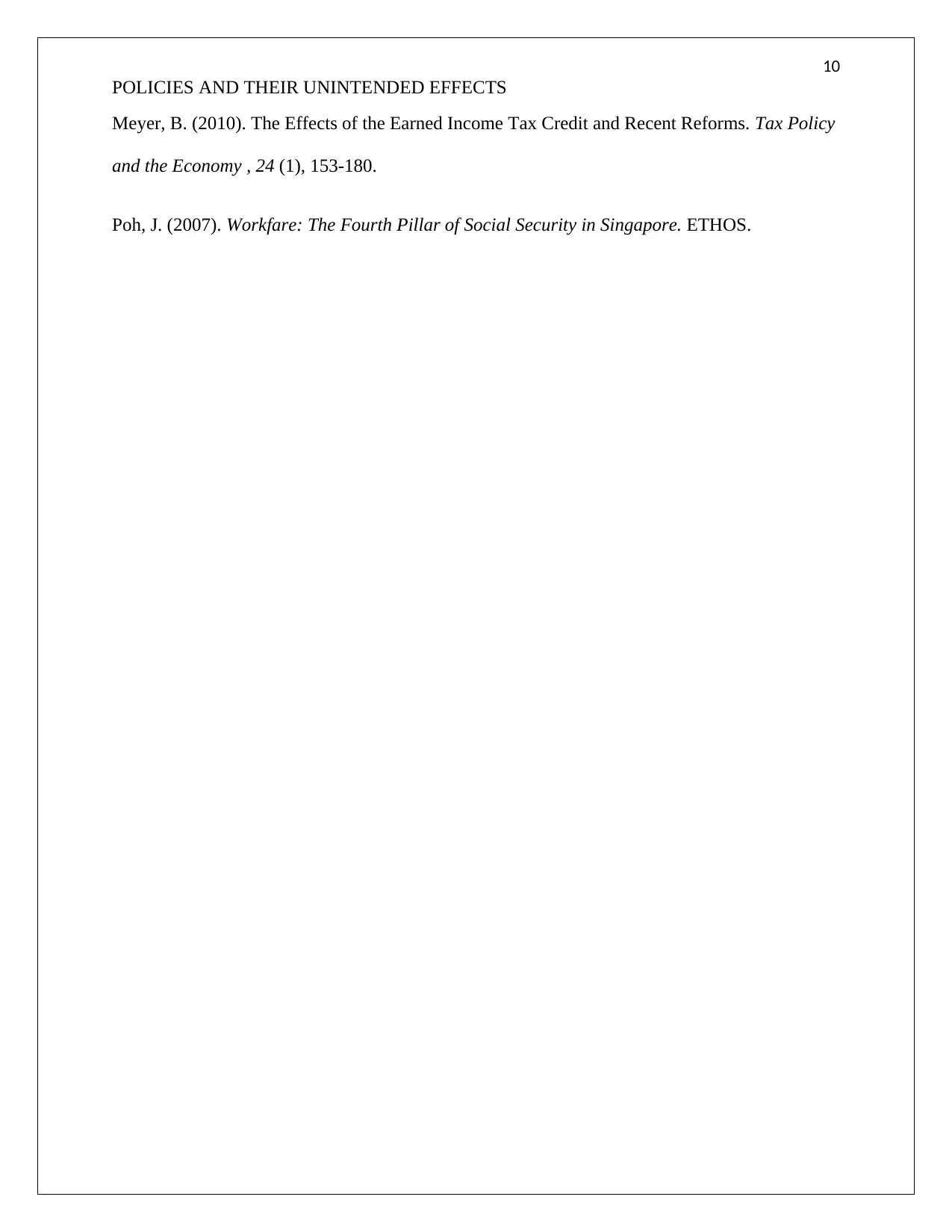
10
POLICIES AND THEIR UNINTENDED EFFECTS
Meyer, B. (2010). The Effects of the Earned Income Tax Credit and Recent Reforms. Tax Policy
and the Economy , 24 (1), 153-180.
Poh, J. (2007). Workfare: The Fourth Pillar of Social Security in Singapore. ETHOS.
POLICIES AND THEIR UNINTENDED EFFECTS
Meyer, B. (2010). The Effects of the Earned Income Tax Credit and Recent Reforms. Tax Policy
and the Economy , 24 (1), 153-180.
Poh, J. (2007). Workfare: The Fourth Pillar of Social Security in Singapore. ETHOS.
1 out of 10
Related Documents
Your All-in-One AI-Powered Toolkit for Academic Success.
+13062052269
info@desklib.com
Available 24*7 on WhatsApp / Email
![[object Object]](/_next/static/media/star-bottom.7253800d.svg)
Unlock your academic potential
Copyright © 2020–2025 A2Z Services. All Rights Reserved. Developed and managed by ZUCOL.





